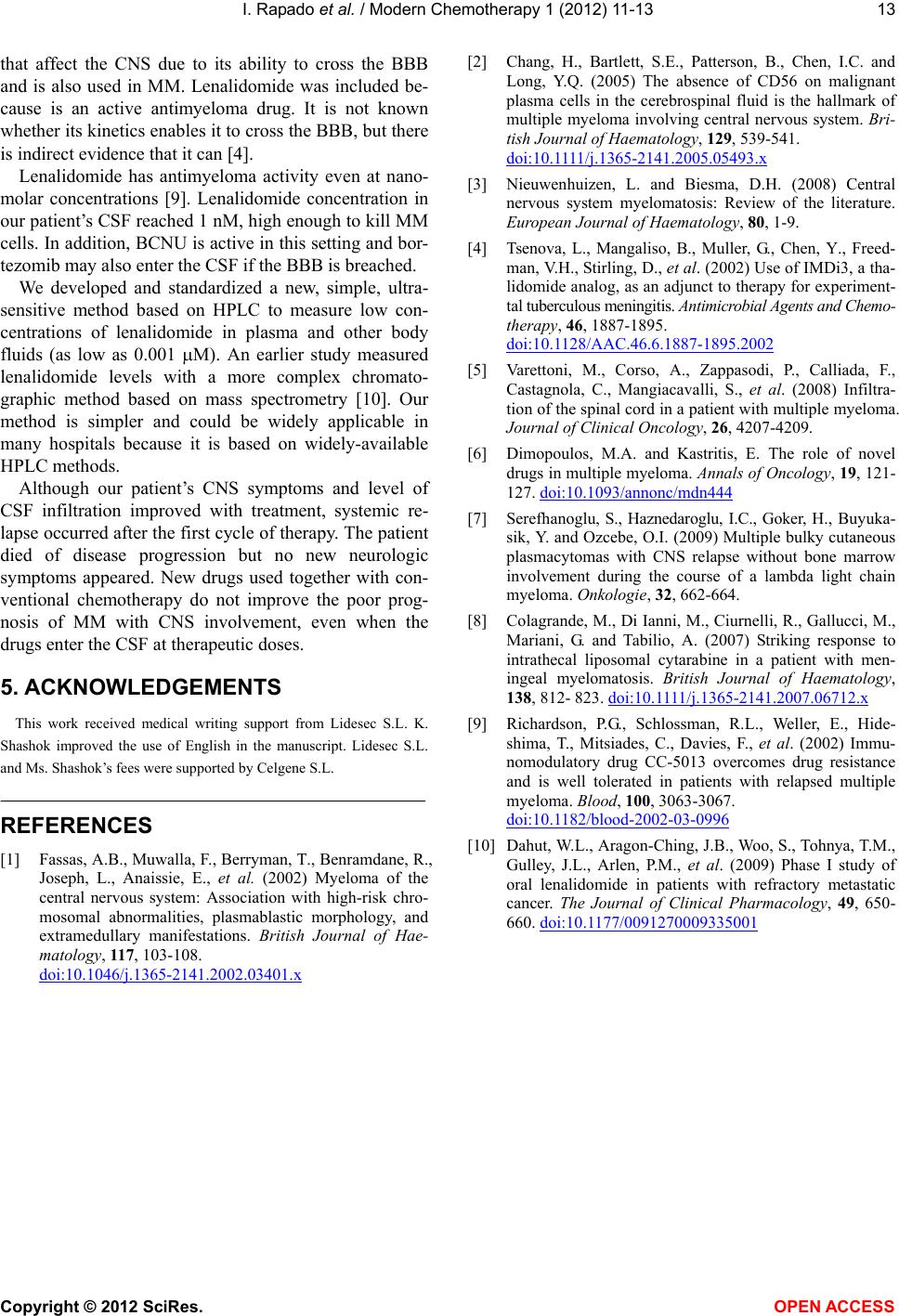
I. Rapado et al. / Modern Chemotherapy 1 (2012) 11-13
Copyright © 2012 SciRes. OPEN ACCESS
13
[2] Chang, H., Bartlett, S.E., Patterson, B., Chen, I.C. and
Long, Y.Q. (2005) The absence of CD56 on malignant
plasma cells in the cerebrospinal fluid is the hallmark of
multiple myeloma involving central nervous system. Bri-
tish Journal of Haematology, 129, 539-541.
doi:10.1111/j.1365-2141.2005.05493.x
that affect the CNS due to its ability to cross the BBB
and is also used in MM. Lenalidomide was included be-
cause is an active antimyeloma drug. It is not known
whether its kinetics enables it to cross the BBB, but there
is indirect evidence that it can [4].
Lenalidomide has antimyeloma activity even at nano-
molar concentrations [9]. Lenalidomide concentration in
our patient’s CSF reached 1 nM, high enough to kill MM
cells. In addition, BCNU is active in this setting and bor-
tezomib may also enter the CSF if the BBB is breached.
[3] Nieuwenhuizen, L. and Biesma, D.H. (2008) Central
nervous system myelomatosis: Review of the literature.
European Journal of Haematology, 80, 1-9.
[4] Tsenova, L., Mangaliso, B., Muller, G., Chen, Y., Freed-
man, V.H., Stirling, D., et al. (2002) Use of IMDi3, a tha-
lidomide analog, as an adjunct to therapy for experiment-
tal tuberculous meningitis. Antimicrobial Agents and Chemo-
therapy, 46, 1887-1895.
doi:10.1128/AAC.46.6.1887-1895.2002
We developed and standardized a new, simple, ultra-
sensitive method based on HPLC to measure low con-
centrations of lenalidomide in plasma and other body
fluids (as low as 0.001 M). An earlier study measured
lenalidomide levels with a more complex chromato-
graphic method based on mass spectrometry [10]. Our
method is simpler and could be widely applicable in
many hospitals because it is based on widely-available
HPLC methods.
[5] V
arettoni, M., Corso, A., Zappasodi, P., Calliada, F.,
Castagnola, C., Mangiacavalli, S., et al. (2008) Infiltra-
tion of the spinal cord in a patient with multiple myeloma.
Journal of Clinical Oncology, 26, 4207-4209.
[6] Dimopoulos, M.A. and Kastritis, E. The role of novel
drugs in multiple myeloma. Annals of Oncology, 19, 121-
127. doi:10.1093/annonc/mdn444
Although our patient’s CNS symptoms and level of
CSF infiltration improved with treatment, systemic re-
lapse occurred after the first cycle of therapy. The patient
died of disease progression but no new neurologic
symptoms appeared. New drugs used together with con-
ventional chemotherapy do not improve the poor prog-
nosis of MM with CNS involvement, even when the
drugs enter the CSF at therapeutic doses.
[7] Serefhanoglu, S., Haznedaroglu, I.C., Goker, H., Buyuka-
sik, Y. and Ozcebe, O.I. (2009) Multiple bulky cutaneous
plasmacytomas with CNS relapse without bone marrow
involvement during the course of a lambda light chain
myeloma. Onkologie, 32, 662-664.
[8] Colagrande, M., Di Ianni, M., Ciurnelli, R., Gallucci, M.,
Mariani, G. and Tabilio, A. (2007) Striking response to
intrathecal liposomal cytarabine in a patient with men-
ingeal myelomatosis. British Journal of Haematology,
138, 812- 823. doi:10.1111/j.1365-2141.2007.06712.x
5. ACKNOWLEDGEMENTS
[9] Richardson, P
.G., Schlossman, R.L., Weller, E., Hide-
shima, T., Mitsiades, C., Davies, F., et al. (2002) Immu-
nomodulatory drug CC-5013 overcomes drug resistance
and is well tolerated in patients with relapsed multiple
myeloma. Blood, 100, 3063-3067.
doi:10.1182/blood-2002-03-0996
This work received medical writing support from Lidesec S.L. K.
Shashok improved the use of English in the manuscript. Lidesec S.L.
and Ms. Shashok’s fees were supported by Celgene S.L.
REFERENCES
[10] Dahut, W.L., Aragon-Ching, J.B., Woo, S., Tohnya, T.M.,
Gulley, J.L., Arlen, P.M., et al. (2009) Phase I study of
oral lenalidomide in patients with refractory metastatic
cancer. The Journal of Clinical Pharmacology, 49, 650-
660. doi:10.1177/0091270009335001
[1] Fassas, A.B., Muwalla, F., Berryman, T., Benramdane, R.,
Joseph, L., Anaissie, E., et al. (2002) Myeloma of the
central nervous system: Association with high-risk chro-
mosomal abnormalities, plasmablastic morphology, and
extramedullary manifestations. British Journal of Hae-
matology, 117, 103-108.
doi:10.1046/j.1365-2141.2002.03401.x